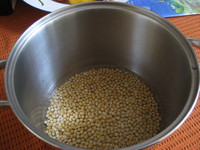 (big)
(big)
Like most food items, the fresher the better, and tofu is no exception. The delicate creamy texture of warm and freshly pressed soy bean curds is something that has been lost to the current Western generation of tofu eaters.
Below is a step by step description of how to make regular tofu. It uses:
Not including bean soaking time, fresh tofu takes about 55 minutes to prepare, plus 20 minutes pressing time.
Take 1 and 1/2 cup of quality soy beans and cover with water 3 times in depth.
Let the beans soak for about 8 to 10 hours at about 20 degrees celsius. Soaking for too long will give the tofu an unpleasant nutty flavour. Soaked beans should fall easily in half and then split again in quarters.
Drain the beans then rinse them once with fresh water.
Boil 7 and 1/2 cups of water in a BIG pot. Blend the soaked beans with 4 cups of extra water (may need to be done in batches) and add to the boiling water. The texture of the soy bean puree ('go' in Japanese) should be yellow and creamy with flecks of bean fibre. It will splash when poured into the boiling water so it is best to pour it down the side of the pot or onto a wooden spoon.
Heat the puree on high heat until it boils violently. Take extra care not to burn the puree on the bottom of the pot: use a thick bottom pot, stir constantly, or use a lower heat.
The puree will be cooked when it froths up to about 4 times its original height (so use a deep pot). If it does not froth up then it will be very difficult to extract the milk from the beans.
Set up a colander over another pot and line the colander with a cheese cloth (or similar cloth with thick weave). Pour the cooked puree into the cloth. The soy milk should drain through the cloth into the pot underneath.
The puree must be milked as thoroughly as possible. Wrap the cloth up and press it down with a wide wooden spoon (or similar) and squeeze as much milk out as possible.
Open the cloth and break up the left over bean fibre (the okara). Add 2 and 1/3 cups of cold water to the okara in the cloth and mix to a consistent slush. Wait for the okara to cool then wrap up the cloth again and squeeze out as much of the milk as possible using your hands.
The final milked okara should be dry and crumbly.
Bring the soy milk to a boil (take care not to burn it on the bottom of the pot) and continue to let it boil for 7 minutes.
At this stage the soy is cooked enough for human consumption and may be used as fresh soy milk.
Mix 1 and 1/2 teaspoon of magnesium chloride (nigari) in 1 cup of cold water. It is possible to use lemon juice instead of magnesium chloride, but a lot more lemon juice is required.
While the milk is still hot, add 2/3 cup of the nigari solution evenly to the milk, stirring constantly. The curds and whey should begin to separate at this stage.
Leave the milk to coagulate for about 5 minutes with a lid covering it.
Sprinkle the rest of the nigari solution evenly over the top of the curds and gently agitate them with a wooden spoon to spread the nigari evenly. Cover and leave the curds for 2 more minutes.
The curds may need further agitation and/or more nigari solution to fully coagulate. They are done when the whey (the liquid) is clear (but still yellow) and contains no milky colour.
Prepare a tofu box (something with holes in it) and line it with a cheese cloth.
Drain the whey from the curds by pouring the whey gently into the tofu box, being careful not to let too many of the curds in the box. Bring the pot back upright a few times to collect the whey.
Finally, pour the curds gently into the tofu box.
Put a lid on the box and press down with medium force to expel more of the whey. Leave a weight (about 1 kg) on the lid while the curds settle for about 20 minutes.
Remove the tofu from the box.
Enjoy fresh with soy sauce and wasabi.
To store tofu, immerse it in enough water to cover it and store it in the fridge. The water will become yellow and cloudy and needs changing every 1 or 2 days. With regularly changed water, the tofu can last up to 6 days, at which point it begins to get slimy.
This method makes regular tofu. Firm tofu can be made easily by expelling more whey from the curds and using a much heavier weight when pressing the tofu at the end. Silken tofu is much more difficult to prepare. It requires a very thick soy milk and the nigari is used to set the soy milk (like jelly) in a plastic tub. There is no curds and whey separation when making silken tofu, and it is harder to make the thick soy milk as it doesn't press out of the okara as easily.
Easy variations on the above recipe include: